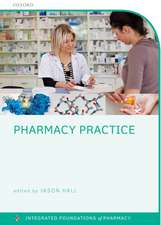Disulfiram and its Metabolite, Diethyldithiocarbamate: Pharmacology and status in the treatment of alcoholism, HIV infections, AIDS and heavy metal toxicity
Autor P.K. Gessneren Limba Engleză Paperback – 16 noi 2012
Preț: 378.60 lei
Preț vechi: 398.53 lei
-5% Nou
Puncte Express: 568
Preț estimativ în valută:
72.44€ • 75.84$ • 59.94£
72.44€ • 75.84$ • 59.94£
Carte tipărită la comandă
Livrare economică 05-19 aprilie
Preluare comenzi: 021 569.72.76
Specificații
ISBN-13: 9789401050289
ISBN-10: 9401050287
Pagini: 476
Ilustrații: XIX, 452 p.
Dimensiuni: 155 x 235 x 25 mm
Greutate: 0.66 kg
Ediția:Softcover reprint of the original 1st ed. 1992
Editura: SPRINGER NETHERLANDS
Colecția Springer
Locul publicării:Dordrecht, Netherlands
ISBN-10: 9401050287
Pagini: 476
Ilustrații: XIX, 452 p.
Dimensiuni: 155 x 235 x 25 mm
Greutate: 0.66 kg
Ediția:Softcover reprint of the original 1st ed. 1992
Editura: SPRINGER NETHERLANDS
Colecția Springer
Locul publicării:Dordrecht, Netherlands
Public țintă
ResearchCuprins
1 Introduction and Scope of Monograph.- 1.1 Introduction.- 1.2 Scope of monograph.- 1.3 Earlier reviews.- 2 Relevant Physical and Chemical Properties.- 2.1 Introduction and general properties.- 2.2 Acid-catalyzed decomposition.- 2.3 Formation of metal complexes.- 3 Reactions of Disulfiram and Diethyldithiocarbamate with Blood Constituents.- 3.1 Introduction.- 3.2 Formation of copper complexes.- 3.3 Formation of mixed disulfides.- 3.4 Uptake of disulfiram by blood cells.- 3.5 Summary.- 4 Assay Methods for Disulfiram and Metabolites in Biological Materials.- 4.1 Introduction.- 4.2 General considerations.- 4.3 Specific methods.- 4.4 Other methods.- 5 Metabolism of Disulfiram and Diethyldithiocarbamate.- 5.1 Introduction.- 5.2 Formation of mixed disulfides with generation of diethyldithiocarbamate.- 5.3 Formation of disulfiram from diethyldithiocarbamate.- 5.4 Formation of the copper complex.- 5.5 S-glucuronide of diethyldithiocarbamic acid.- 5.6 Formation of carbon disulfide and diethylamine.- 5.7 Metabolism of carbon disulfide and formation of carbonyl sulfide.- 5.8 The methyl ester of diethyldithiocarbamic acid.- 5.9 The methyl ester of diethylmonothiocarbamic acid.- 5.10 Other metabolites.- 6 Pharmacokinetic Aspects of the Disposition of Disulfiram and Metabolites.- 6.1 Introduction.- 6.2 Methods.- 6.3 Urinary excretion of disulfiram metabolites.- 6.4 Pulmonary excretion of disulfiram metabolites.- 6.5 Plasma disulfiram and metabolites following its administration.- 6.6 Diethyldithiocarbamate and metabolites following its administration.- 7 Heavy Metals: Effects of Diethyldithiocarbamate and Disulfiram Administration.- 7.1 Introduction.- 7.2 Thallium.- 7.3 Zinc.- 7.4 Cadmium.- 7.5 Lead.- 7.6 Nickel.- 7.7 Copper.- 7.8 Mercury.- 7.9 Platinum.- 7.10 Polonium.- 8 Disulfiramand Diethyldithiocarbamate as Enzyme Inhibitors.- 8.1 Introduction.- 8.2 Inhibition of drug metabolizing enzymes.- 8.3 Inhibition of dopamine ?-hydroxylase.- 8.4 Inhibition of superoxide dismutase.- 8.5 Inactivation of glutathione peroxidase.- 8.6 Effect of catalase.- 9 Inhibition of Aldehyde Dehydrogenase.- 9.1 Introduction.- 9.2 Phenomenology of the inhibition by disulfiram.- 9.3 Mechanism of the inhibition.- 9.4 Role of disulfiram metabolites.- 9.5 Inhibition of aldehyde dehydrogenases in blood.- 9.6 Inhibition of metabolism of endogenous aldehydes.- 9.7 Aldehyde and xanthine oxidases.- 10 The Disulfiram-Ethanol Reaction.- 10.1 Introduction.- 10.2 Discovery and therapeutic application.- 10.3 Pharmacological characteristics.- 10.4 Blood acetaldehyde determination.- 10.5 The acetaldehyde hypothesis.- 10.6 Quest for animal models of the reaction.- 10.7 Effect of disulfiram on ethanol metabolism.- 10.8 The dopamine ?-hydroxylase hypothesis.- 10.9 Effect of ethanol in animals pretreated with disulfiram metabolites.- 10.10 Treatment of the disulfiram-ethanol reaction.- 11 Disulfiram Therapy of Alcohol Abuse.- 11.1 Introduction.- 11.2 Goals of disulfiram therapy.- 11.3 Disulfiram treatment components correlated with reduction of drinking days.- 11.4 Disulfiram therapy paradigms.- 11.5 Election of and continuation in treatment.- 11.6 Characteristics of disulfiram’s therapeutic effects.- 11.7 Side effects of disulfiram therapy.- 11.8 Chemical compliance monitoring.- 11.9 Disulfiram implants.- 12 Immunomodulatory Effects of Diethyldithiocarbamate.- 12.1 Introduction.- 12.2 Stimulation of antibody response to sheep red blood cells.- 12.3 Enhancement of mitogen-induced lymphoproliferation.- 12.4 Effect on lymphoproliferative response to alloantigens.- 12.5 Interaction withasymmetrical neocortical lesions.- 12.6 Effects on cell-mediated cytotoxicity.- 12.7 Effect on delayed-type hypersensitivity reaction.- 12.8 Induction of T-cell differentiation.- 12.9 Effect on lymphocyte populations in vivo.- 12.10 Effects on mononuclear phagocytic cells.- 12.11 Experimental therapeutics.- 12.12 Immunomodulatory effects of related compounds.- 12.13 Conclusions.- 13 Clinical Status of Diethyldithiocarbamate as an Immunostimulant.- 13.1 Introduction.- 13.2 In the treatment of HIV infections and AIDS.- 13.3 In gastrointestinal surgery patients.- 13.4 As a therapeutic agent in autoimmune disease.- 13.5 In patients with neoplastic disease.- 13.6 As an adjuvant for influenza vaccination.- 13.7 Summary.- 14 Modulation of Various Biological Phenomena.- 14.1 Cytotoxicity.- 14.2 Modulation of the effects of oxidative stress.- 14.3 Modulation of the effects of radiation and hyperthermia.- 15 Modulation of Cancer Chemotherapy.- 15.1 Introduction.- 15.2 Preclinical studies.- 15.3 Clinical studies.- 15.4 Conclusions.- 16 Toxicology.- 16.1 Introduction.- 16.2 Acute toxicity.- 16.3 Chronic toxicity.- 16.4 Effects on liver.- 16.5 Testing for mutagenicity.- 16.6 Testing for carcinogenicity.- 16.7 Testing for teratogenic and reproductive toxicity.- References.- Author and citation index.
Recenzii
...a well written, detailed publication on literally everything the reader would wish to know about disulfiram and its metabolite - British Journal of Psychiatry; This well written and carefully edited volume deserves the interest of toxicologists, pharmacologists, immunologists, biochemists and clinicians. Journal of Applied Toxicology; It is hoped that clinicians and behavioral scientists have read this book for their own education and also to appreciate the advances made in the biochemical pharmacology of DSSD and SSH. This book should capture the interest of medicinal chemists and pharmacologists who are engaged in research in cancer, immunomodulation, HIV, and heavy metal toxicity. Selected chapters are must reading for biomedical scientists pursuing alcoholism research. Journal of Medicinal Chemistry





